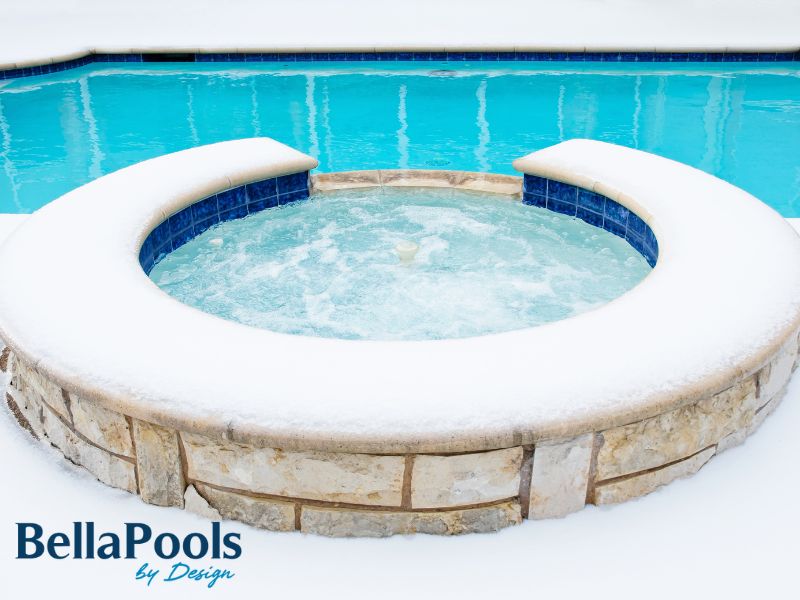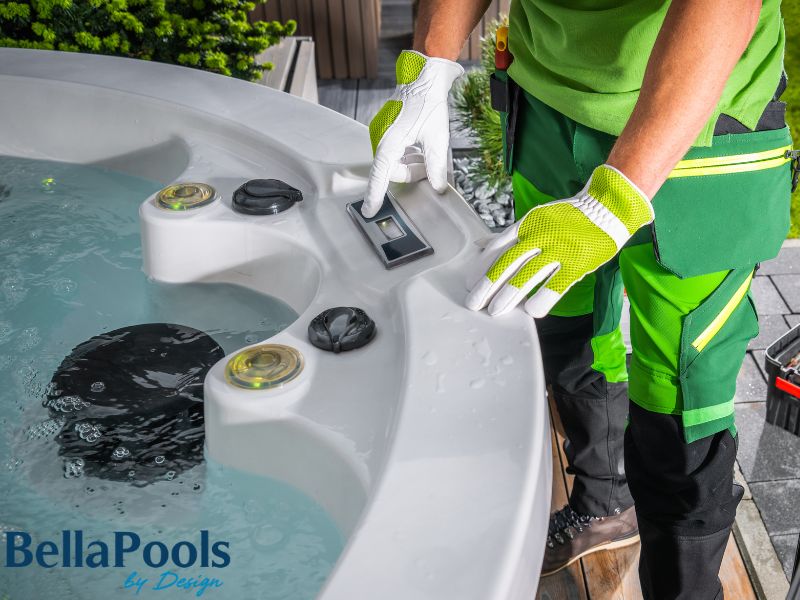How to Winterize a Hot Tub: 10 Steps to Protect Your Investment
A luxury hot tub is more than a seasonal indulgence—it’s an investment in your lifestyle and well-being. But when the freezing temperatures of winter set in, even the highest-end hot tubs are vulnerable to damage if not properly maintained.
Join our custom luxury pool builders from Bella Pools by Design as offer this step by step hot tub winterization guide to homeowners to ensure your spa system stays safe, clean, and ready to enjoy when the weather is right.
1. Decide Between Using or Shutting Down Your Hot Tub for the Season
Before winterizing, determine whether you plan to use your hot tub regularly during the winter months or shut it down completely.

If you plan to continue using your integrated hot tub or spa, you’ll need to maintain proper water chemistry, monitor water temperature, and ensure your hot tub cover is well-insulated to retain heat and reduce energy costs.
If you plan to stop using your hot tub in winter, it must be fully winterized to prevent freezing and damage to plumbing, jets, and internal components. Leaving hot tub water in the tub or lines during cold months—even a small amount—can lead to cracked pipes and costly, inconvenient repairs.
2. Turn Off the Power and Shut Down the Electrical Panel
Before draining or cleaning your hot tub or swim spa, it’s critical to disconnect all electrical power to avoid the risk of shock or damage to your equipment. Powering down properly prevents the heater or pump from running dry during the winterizing process and protects internal components from damage as the spa is drained. Never perform maintenance while the hot tub is still connected to power.
Steps to Safely Power Down Your Hot Tub
- Turn off the breaker at the main electrical panel: Locate the breaker dedicated to your hot tub and switch it to the “off” position. This stops power to the pump, heater, jets, and control panel.
- Double-check that power is fully disconnected: Confirm that the spa’s control panel is off and no lights, circulation, or jets are running.
- Shut off the spa’s dedicated disconnect box (if present): Many hot tubs have a local disconnect panel near the spa—this should be turned off as well.
3. Drain All the Water From the Hot Tub and Internal Plumbing
To prevent freeze damage during the winter months, you must remove all the water from your hot tub—not just the basin, but the plumbing, pumps, and jets as well. Any remaining water can freeze, expand, and crack your system. Even small amounts of leftover water in jets or lines can freeze and cause cracks, so this step must be done thoroughly.
Steps to Drain the Hot Tub Basin
- Attach a garden hose to the spa’s drain spout or use a submersible pump for faster drainage.
- Open the drain plug and allow all the water to flow out completely.
- Once drained, tilt or push water toward the drain to remove as much water as possible from the shell of the tub.
How to Drain Internal Hot Tub Components
- Open all drain plugs on the pump housing and heater (refer to your spa’s manual).
- Loosen any bleed valves to release trapped water in the plumbing lines.
- Remove and drain the filter basket and filter housing.
4. Blow Out the Plumbing Lines to Prevent Freezing
Draining alone won’t remove all the water from your hot tub’s plumbing. You must blow out the lines to eliminate remaining water that could freeze and damage internal components like jets, pumps, and valves. Work methodically from one section to the next, repeating until every line is clear of water. This step is critical to prevent freeze-related damage during cold months, especially if you won’t be using your hot tub in winter.
Tools You’ll Need
- A shop vac (wet/dry vacuum) with blower function or a dedicated air blower
- Towels or rags to catch any expelled water
- Protective eyewear (recommended)
Steps to Blow Out the Hot Tub Plumbing
- Switch your shop vac or blower to “blow” mode.
- Place the nozzle against each jet—one at a time—and force air through until no water comes out.
- Blow air through the filter cavity and skimmer line as well.
- Target all drain lines and plumbing connections, including the pump housing and heater.
5. Remove, Clean, and Store Hot Tub Filters and Accessories
Filters and accessories left inside your hot tub over winter can trap moisture, freeze, or develop mold. Removing and properly storing these components helps maintain water quality and protects your spa system. Store all items in a clean, dry space indoors until you’re ready to use the hot tub again.
Steps to Clean and Store Hot Tub Filters

- Remove the filters from the filter cavity—most hot tubs have one or two cartridges.
- Rinse each filter thoroughly with a hose to remove debris.
- For deeper cleaning, soak the filters in a designated spa filter cleaner, then rinse and allow them to completely dry.
- Inspect for wear and tear. If they’re damaged or overly worn, replace them before reopening the hot tub in spring.
- Don’t forget to take out the filter basket and cover cap as well as remove and store any detachable pillows, skimmer components, or spa steps that may be affected by the cold.
6. Add RV Antifreeze to Protect Against Freezing Temperatures
Even after draining and blowing out your lines, small amounts of leftover water can remain in pipes and equipment. Adding non-toxic RV anti freeze provides an extra layer of protection during freezing temperatures—especially in hard-to-reach areas.
Make sure the non-toxic RV antifreeze product is formulated for RV and marine systems, not automotive antifreeze, and check the label to ensure it’s safe for use in hot tub plumbing.
How to Add Antifreeze
- Pour antifreeze into all jets and plumbing lines using a funnel or turkey baster.
- Add antifreeze to the filter cavity, pump housing, and heater lines.
- Force antifreeze through low points and fittings where leftover water might collect.
Add enough to displace any remaining water and coat the inside of the pipes. You don’t need to fill the lines—just ensure enough antifreeze is present to prevent freezing.
7. Clean the Hot Tub’s Shell and Interior
Before covering your hot tub for the winter season, it’s important to clean the shell and interior components. This prevents buildup, staining, and bacteria growth while the spa is not in use. A clean, dry interior helps protect your investment and ensures your hot tub is ready for use when warmer weather returns.
Steps for Thorough Hot Tub Cleaning
- Wipe down the hot tub’s shell using a non-abrasive cloth and a spa-safe cleaner. Avoid harsh chemicals that can damage the surface or leave residue.
- Flush out the jets with clean water or a spa system flush product to remove trapped debris or biofilm.
- Dry all surfaces completely with towels to prevent mold or mildew during storage.
Areas of the Hot Tub Interior to Clean
- Jet nozzles
- Seat contours and steps
- The inside of the filter cavity and skimmer area
- Drain area and any exposed fittings
8. Cover Your Hot Tub Properly and Secure the Lid
Once your hot tub is clean, dry, and winterized, covering it properly is the final—and essential—step in protecting it from snow, ice, and debris during the winter months. It’s important to choose a well-fitted hot tub cover that’s insulated and in good condition—no cracks, sagging, or waterlogging.
Make sure the cover seals tightly to prevent heat loss, moisture intrusion, or snow buildup. A properly secured and insulated cover helps maintain energy efficiency, prevents freezing damage, and keeps pests, debris, and moisture out of your hot tub during winter.
How to Secure the Hot Tub Cover
- Fasten all straps or cover clips to keep the lid from lifting in wind or heavy snow.
- For added protection, consider using a cover cap or weatherproof tarp over the existing cover.
- If your area gets snow, regularly remove buildup to prevent weight damage or cover warping.
9. Inspect for Leaks, Leftover Water, or Missed Steps
Before walking away from your winterized hot tub, take time to double-check that every step has been completed thoroughly. Small oversights—like leftover water in a pipe or a missed valve—can lead to freeze damage and costly repairs.
Perform a Final Walkthrough
- Confirm that all electrical components are shut off at the breaker and local disconnect.
- Check for any visible water left in the shell, pump housing, or plumbing lines.
- Inspect around jets, valves, and the filter cavity for pooled water or moisture.
- Ensure all drain plugs are open and all air has been blown out of the lines.
- Make sure the cover is sealed tightly and strapped down.
Look for Signs of Leaks or Cracks
- Check underneath the hot tub cabinet for moisture, staining, or drips.
- If you notice anything unusual, now is the time to address it—before freezing temperatures set in.
This final check in the process for how to winterize a hot tub ensures you won’t discover problems in the spring that could have been prevented with a few extra minutes of inspection.
10. Schedule Seasonal Maintenance or Professional Winterizing Help
If you’re unsure about any step—or simply prefer expert handling—it’s smart to schedule professional service. A licensed pool technician can ensure every component of your hot tub is properly winterized, reducing the risk of freeze damage and avoiding costly repairs.
Why Professional Winterizing Matters

- Specialists know what to look for: They’ll inspect pump housing, valves, and hot tub plumbing to ensure no remaining water is left behind.
- They use the right tools: From shop vacs to non-toxic antifreeze, professionals have the equipment to do the job safely and thoroughly.
- You protect your investment: Hiring a professional minimizes risks to your hot tub’s shell, internal systems, and long-term performance.
Hot Tub Winterization FAQs
What’s the ideal hot tub temperature if I’m using it in winter?
Between 100°F and 104°F is safe and comfortable for winter use.
Can I just keep the heater running all winter instead of winterizing?
Yes, but you must maintain water levels, monitor temperature, and keep the cover secure.
Do I still need to winterize my hot tub if I plan to use it all winter long?
No, if you plan to use your hot tub all winter, full winterization isn’t necessary—but you must keep the water properly balanced, maintain a steady temperature, and ensure your hot tub cover is in excellent condition to prevent heat loss and freeze damage.
How often should I check my hot tub in winter if I’m still using it?
Check it at least once a week to ensure proper temperature, water level, and cover condition.
Is RV antifreeze safe for hot tub plumbing?
Yes—use only non-toxic RV antifreeze specifically made for water systems.
What happens if I forget to drain a line or valve?
Leftover water can freeze, expand, and crack pipes or internal components, leading to the need for pricy and extensive hot tub repairs.
Design and Build Your Custom Pool, Spa, or Outdoor Space in Raleigh
Turn your property into a private resort with Raleigh’s leading custom pool builder, Bella Pools by Design. We create extraordinary concrete pools, gunite pools, freeform pools, integrated spas, and full outdoor living environments tailored to your lifestyle. From concept to construction—we handle every detail with the craftsmanship Raleigh homeowners expect.
Contact our custom pool contractor today for a personal design consultation by calling us at (919) 465-1965 or filling out our contact form to get started.
© 2025 Bella Pools by Design. All Rights Reserved.
SEO + Internet Marketing by TheeDigital
